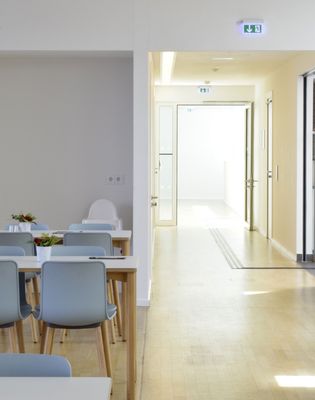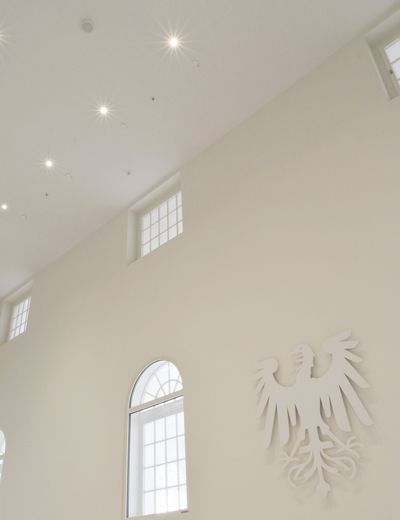Potsdam City Palace
With INOTEC’s solution, maximum safety for people and nature

On the Old Market in the heart of the city of Potsdam, a collection of buildings, known as the “Stadschloss Potsdam”, or City Palace, was built in the 17th century to the plans of the architect Georg Wenzeslaus von Knobelsdorff. After they had been destroyed in World War II, the ruins were cleared away during the GDR era. In 2010, after many years of discussions, work began on a reconstruction in the style of Knobelsdorff's original.
The impetus for this had been given in 2001 by TV host Günther Jauch during the Bundesgartenschau (the biennial Federal horticulture show) in Potsdam. With the help of sponsors and donations, the Fortuna Gate was rebuilt true to the original design in 2002, and today serves as the entrance to the Brandenburg state parliament building.
To begin with, because of limited funds, the building was planned as a purely functional edifice, but – thanks to a generous donation – the historical façade could be rebuilt. Behind the tripartite façade are four floors of modern offices constructed using the latest building technology.
Location requires special water protection provisions
As a political and public building, the palace is covered by the state’s regulation for places of public assembly and therefore requires emergency and safety lighting. The first designs, for this building of around 35,000 square metres, provided for a central battery system. The batteries for the backup power supply were to be housed in the building’s cellars. However, due to its location on the banks of the Havel and the adjacent water protection zones, concerns were raised about the water protection issues. The goal was to reduce the size of the battery installation in the basement to avoid any possible contamination through faulty batteries in case of flooding.
A minimisation of the required battery capacity was achieved in the first instance by the use of special LED emergency-exit and safety luminaires. The integration of general luminaires with monitoring modules into the safety lighting would have necessitated a larger battery installation. However, thanks to the LED safety luminaire, which is optimised for escape routes, this has significantly reduced the demand.
Decentralised emergency system instead of central battery system
As a further safety measure, it was decided to use the CLS 24 decentralised emergency system from INOTEC, rather than a central battery system. The decentralised system has the advantage of making a large battery installation in the basement unnecessary. The individual CLS systems are housed locally in each fire compartment and only supply the emergency-exit and safety luminaires within a single fire compartment. The need for extensive E30 cabling and cable transits, and housing in a separate plant room, was then also eliminated.
Going on with the planning of the building technology it turned out, that avoiding a battery systems in the basement, because of other safety technology devices (for example a USB), would not have been possible. At the end the complete Landtag was set into a “White tank” for flood protection.
But we remained with the use of the decentralised system CLS 24, because the building structure did not provide enough space for the accordingly dimensioned vertical ducts, which would be necessary for a centralised safety lighting. This would have caused a complex rearranging. Because of the concept of the decentralised arrangement of the emergency lighting systems we could do it without additional vertical ducts and simply use space available for the planned purposes.
A total of 42 CLS systems now ensure safety in the Brandenburg state parliament building. Thanks to the central network and connection to the INOWeb Control monitoring module, the system information can be accessed on the central point in the porter's area. Mr. Angerstein of BAM Immobilien-Dienstleistungen GmbH, who is responsible for the facility management of the Brandenburg state parliament building, is delighted with the solution: “Since its installation, the system has worked faultlessly. At the same time, any faulty luminaires can be quickly located thanks to the monitoring and automatic test functions.”
Furthermore, the safety lighting’s safety level is substantially increased by the use of multiple CLS 24 decentralised systems compared to using a single central battery installation in the basement. If one CLS 24 system should fail, all the other systems would continue to work.
Project overview
| Property: | Landtag Brandenburg |
|---|---|
| Client: | Land Brandenburg, BAM PPP Landtag Potsdam Projektgesellschaft mbH |
| Execution: | BAM Deutschland AG |
| Architect: | Peter Kulka Architektur Prof. Peter Kulka, Henryk Urbanietz |
| Electrical design: | IB Ziesche |
| Electrical installation: | Wahlen & Schabbach |
INOTEC sales representative: | Stefan Stetefeld |
| INOTEC products: |
|
Long-lasting LED luminaires in harmony with the architecture
To light the emergency escape routes, INOTEC SN 9104 LED 24V and SN 9024 LED 24V recessed ceiling luminaires have been used. These safety luminaires have been painted the same colour as the ceiling, so fit harmoniously into the ceilingscape. In order to reduce the battery capacity still further, the main luminaire used in the corridors was the SN 9104-11 LED 24V, with a single Power LED and 80mA rated current (Ibatt) with 24V. Where necessary, for instance in the corridor intersections, the variants were used with 4 Power LEDs (SN 9104-41) and 200mA rated current with 24V.
An additional advantage of LED lighting is the illuminant’s long service life. The ceiling in the plenary room is up to 22 metres high. Having to replace illuminants always creates problems for the building service engineers, as at these ceiling heights they have to work with scaffolding or boom lifts. The use of LED safety luminaires means that the intervals between replacing the illuminant are increased to a maximum, and maintenance costs are considerably reduced as a consequence.
Target achieved: safety for staff and visitors
Behind the historical façade of the Brandenburg state parliament building, the rooms are constructed to today’s standards using state-of-the-art building technology, and not just in the case of the emergency and safety lighting. The goal of reducing the battery capacity in the basement was brilliantly achieved through the decentralised system offered by the INOTEC CLS 24. The planned architecture of the building without additional vertical ducts was maintained as well due to the CLS concept.
Intervals between replacing illuminants were increased to a maximum, while costs for cabling and cable transits were reduced to a minimum. The most important thing, however, is that, thanks to the combination of decentralised technology and LED illuminants, and the resulting high availability of the complete system, an extremely high safety objective was achieved. So, in an emergency, not only the members and staff of the state parliament but also the countless visitors can leave the building in safety.






